Essential Guide to Selecting a Waterproof Camera for Surfing
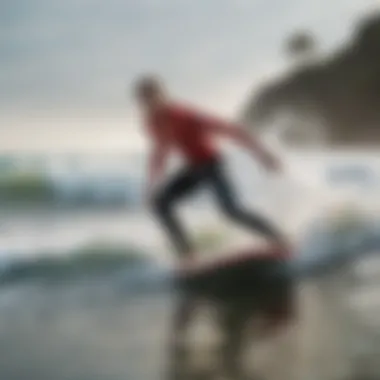
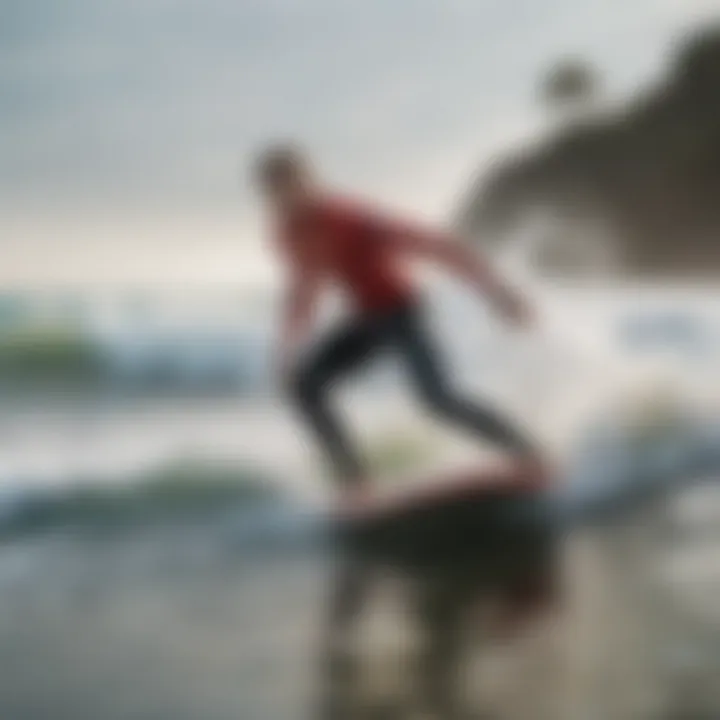
Intro
Finding the right waterproof camera for surfing can feel like searching for a needle in a haystack. With so many choices out there, each boasting different features, it’s crucial to zero in on what truly matters. Surfers today want to capture breathtaking moments without worrying about their gear getting waterlogged. Whether you are a novice aiming to document your early days on the waves or a seasoned pro looking to elevate your photography skills, knowing what to look for in a waterproof camera makes all the difference.
Surfing often takes place in dynamic environments, where conditions can shift from calm to chaotic in the blink of an eye. This makes durability and ease of use paramount when selecting a camera. The ideal model won’t just be robust against water but will also handle the rough and tumble of being in the ocean.
In this guide, we’ll delve into essential gear recommendations tailored for both beginners and professionals, share techniques and tips to improve your skills, and highlight maintenance advice that extends your camera’s life. Each section aims to create a clearer picture of how to make informed decisions about your gear—after all, capturing that perfect wave is worth the effort.
"A picture is worth a thousand waves, but a great camera is worth every penny."
By equipping yourself with the right knowledge, you can maximize both your surfing and photography experience, resulting in beautifully captured memories of your adventures in the water.
Understanding the Need for Waterproof Cameras in Surfing
Surfing, by its very nature, is a dance with the ocean. It's exhilarating, unpredictable, and often a little wild. The need for a reliable waterproof camera in this context goes beyond capturing a mere picture; it’s about preserving awe-inspiring moments against a backdrop of raging waves and salty spray. Selecting the right waterproof camera can redefine how surfers document their adventures.
The Nature of Surfing Conditions
Surfing conditions are not just a simple background; they are dynamic and, at times, quite harsh. The interactions between wind, water, and the surfboard create an environment that can be as beautiful as it is challenging. When you are gliding over a wave or when a giant swell breaks over you, the very composition of the scene changes in split seconds. An ordinary camera won’t hold up in such conditions. A good waterproof camera has to withstand not just water but also sand, bumps, and the pressures of high action.
Moreover, factors such as lighting can be tricky. Bright sunlight reflecting off the water can create glare, making it hard to capture sharp images. Conversely, low light during dawn or dusk offers tantalizing opportunities for stunning shots, if only the camera can handle it. Potential buyers need to consider not just the water resistance ratings but other elements like image stabilization and lens quality that greatly affect performance during unpredictable conditions.
Importance of Capturing the Experience
It's not just about snapping a few pics; capturing moments while surfing brings a whole new dimension to the experience. Think about it: that still frame of you gliding down a perfect wave can evoke emotions that go beyond words. The best waterproof cameras allow surfers to encapsulate these ephemeral feelings, providing a means to relive those exhilarating rides long after the water has dried.
Furthermore, there’s a broader social aspect to consider. Sharing remarkable surfing moments on platforms like Facebook or Reddit can foster connections within the surfing community. It inspires others, pushes boundaries, and keeps the spirit of adventure alive. A good shot can tell a story, spark conversations, and encourage friends—or even strangers—to hit the waves themselves. Moreover, having quality photos makes you feel proud of not just your surfing but your ability to share those moments as well.
"A good camera can capture a wave, but only a great camera can capture the magic as it crashes beneath the board."
In the surfing world, these reasons underscore the undeniable need for a waterproof camera. As a surfer prepares to tackle the waves, the gear they choose should be as robust and adventurous as the sport itself.
Key Features to Consider in a Waterproof Camera
Choosing the right waterproof camera for surfing is not just about picking one that’s waterproof. A quality camera can enhance your surfing experience and capture those exhilarating moments on the waves. When thinking about the right features, several critical elements come to the forefront. Each one impacts how effectively you can document your surf adventures and stash away memories that last a lifetime.
Water Resistance Ratings Explained
Water resistance is at the heart of a waterproof camera. Understanding IP ratings can help you make an informed choice. For instance, an IP68 rating means that the camera is fully dust-tight and can withstand being submerged in water beyond 1 meter for extended periods. This level of resistance is valuable when you find yourself tossed around by waves. There are other ratings like IPX7, which means the camera can handle immersion in water for a short while but lacks other protective features. Take the time to check these ratings; no one wants a camera that fizzles out after a splash or two.
"It doesn't matter how flashy a camera looks; if it can’t handle a bit of water, it’s not worth the bother."
Camera Stability and Lens Quality
When you’re riding high on a wave, your camera must keep up. Stability is crucial, not just for capturing the action but for ensuring that the images are sharp and well-defined. Look for cameras with optical image stabilization—this feature compensates for any sudden movements, enabling clearer shots. Similarly, lens quality matters greatly. A good lens will ensure that you aren’t just getting a blurry memory but a vivid picture that brings you back to the thrill of the ocean. Check for features such as wide-angle views, ideal for capturing expansive beachscapes alongside your pals catching waves.
Image Resolution and Frame Rates
Today’s technology offers cameras capable of remarkable image resolution and high frame rates. If you want to catch every detail of that perfect wipeout, pay attention to resolution. A camera boasting 4K resolution can transform your surfing videos into a cinematic experience. 1080p is also good but may not deliver the same immersive detail. In addition, consider the frame rates; higher frame rates (like 60 frames per second) are essential for capturing smooth motion when you’re zipping through the water. It’s like riding a wave of pixels!
Portability and Ease of Use
Surfers need gear that doesn’t weigh them down. That’s why portability should be a staple in your camera choice. Compact models can fit snugly in your swim shorts pocket or a small bag. On top of this, ease of use is essential. Look for a camera with user-friendly interfaces and intuitive controls. The last thing you want is to be fumbling around trying to snap a picture because the menu is too complicated. Features like touch screens can make switching modes or settings a breeze, even when your hands are wet!
Top Waterproof Cameras for Surfing
When it comes to capturing the thrill of riding the waves, the type of camera an athlete picks can make a world of difference. Surfers know that not all cameras are built equal; hence, selecting the right waterproof camera is paramount for quality footage and lasting durability. Exploring this topic is vital for ensuring that surfers can document their adventures effectively while making informed decisions on what models serve their needs best.
In this segment, we will delve into various categories of waterproof cameras, breaking them down into three groups: high-end options, mid-range cameras, and budget-friendly choices. Each category bears its unique features and advantages, making it crucial for surfers to understand what they offer.
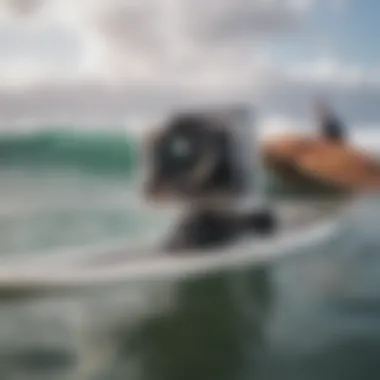
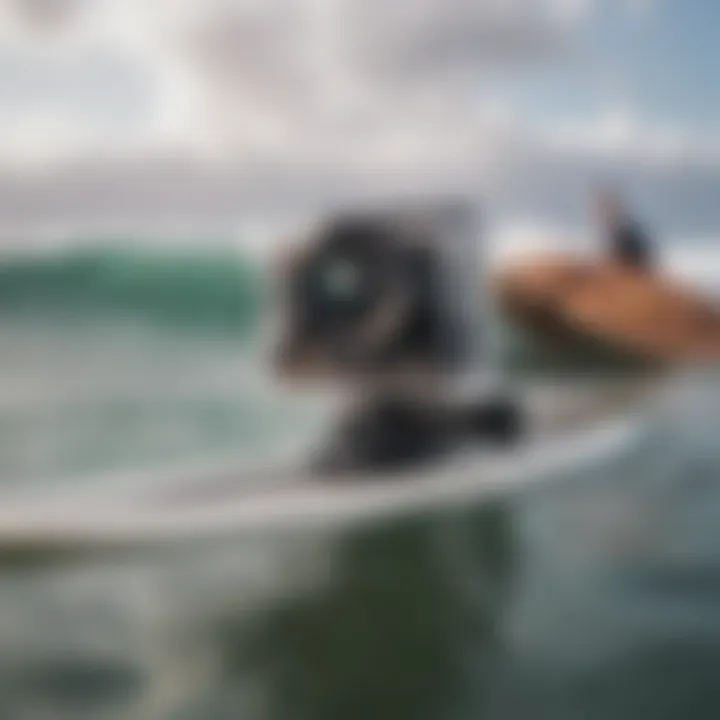
High-End Options
For those willing to splurge a bit more, high-end waterproof cameras present top-notch features that can elevate your surfing photography game. These models often come packed with advanced technology, offering exceptional image quality, superior low-light performance, and faster processing speeds. Notable examples include the GoPro HERO11 Black and Sony RX0 II.
- GoPro HERO11 Black: Known for its rugged build, this camera is designed specifically for action sports. Its HyperSmooth video stabilization helps keep footage steady, even in the roughest conditions.
- Sony RX0 II: This compact powerhouse provides stunning 4K video and impressive dynamic range, making it ideal for capturing intricate water details.
Investing in high-end options like these means you get features that grant more control and versatility, whether surfing in sunlight or amidst waves.
Mid-Range Cameras
Mid-range options cater to those who seek a balance between performance and price. These models typically still offer solid capabilities, suitable for experienced surfers and hobbyists alike. Choices such as the Olympus TG-6 and DJI Osmo Action strike a great balance.
- Olympus TG-6: This camera shines with its macro shooting mode, allowing users to capture underwater life with stunning detail. Its robust design withstands both water and tough impacts, making it a solid choice for adventurous surfers.
- DJI Osmo Action: Featuring dual screens, this option allows you to frame your shots perfectly. The RockSteady stabilization technology helps reduce shake, ensuring smooth footage.
Mid-range cameras resemble a wise investment for surfers looking for quality without breaking the bank; they combine usability and creativity without overwhelming complexity.
Budget-Friendly Choices
For surf enthusiasts on a tighter budget, there are some great cameras that still deliver excellent performance. These options may not have all the bells and whistles of higher-priced alternatives, but they function sufficiently to capture memorable moments on the water. Choices like the Kodak PIXPRO WPZ2 and Akaso Brave 7 LE can be appealing.
- Kodak PIXPRO WPZ2: This rugged model is waterproof up to 10 meters, perfect for quick dips and splashes.
- Akaso Brave 7 LE: Known for its affordability, it's a user-friendly action camera that shoots 4K video, making it a solid entry point for budding surfers.
Budget-friendly options can serve as a reliable introduction to underwater photography for many. They may lack the sophistication of more expensive alternatives, but they offer enough functionality to record those exhilarating surf sessions without financial strain.
Choosing the right waterproof camera isn’t just about price; it’s about finding a model that fits your personal needs and preferences so you can enjoy surf adventures more fully.
Advantages of Using a Waterproof Camera
In the world of surfing, there’s a saying: you miss a hundred percent of the waves you don’t take. In photography, it’s somewhat similar — if you don’t equip yourself with the right tools, you’re likely to miss out on capturing those unforgettable moments. Waterproof cameras stand out as essential gear for any surfer, bringing a variety of benefits that go beyond merely withstanding water exposure.
Durability and Longevity
When you’re out there wrestling with waves, the last thing you want to be worried about is whether your camera can take a dunk. Waterproof cameras are designed to endure both the elements and the rigors of active outdoor use. Their sturdy construction often includes impact resistance, which is a relief when navigating rocky shores or slippery surfaces.
Think about it: a camera that can handle saltwater, sand, and the occasional drop? That’s not just a bonus; it’s a necessity for a surf enthusiast. Most models boast rugged materials and seals to keep moisture at bay, enhancing their lifespan significantly compared to regular cameras. Investing in a waterproof camera means you’re likely to enjoy your gear for years, saving you from frequent replacements.
Enhanced Photography Opportunities
One of the beauty of surfing is its unpredictability. Each wave presents a new opportunity, and a waterproof camera allows you to seize those fleeting moments. Imagine capturing the effortless glide of a surfer against the backdrop of a brilliant sunset or the sheer intensity of a wave crashing down.
Waterproof cameras often come with features that cater to action shots: fast shutter speeds, advanced autofocus, and high frame rates. These functionalities enable photographers to snap away while being tossed around in the surf, allowing for stunning shots that tell a story in every frame. They help showcase the dynamics of the ocean and the thrilling adrenaline rush that comes with riding the waves.
Ease of Sharing Moments
In today's digital age, sharing experiences has become almost essential. The instant gratification of posting photos or videos of your surf adventures draws friends, followers, and fellow enthusiasts into your world. With a waterproof camera, capturing and sharing these experiences becomes seamless. You can shoot underwater shots or even document that killer wave you just rode without any second thoughts.
Additionally, many modern waterproof cameras offer built-in Wi-Fi or Bluetooth capabilities, allowing you to transfer your images directly to your device for immediate sharing. No more waiting until you’re back on dry land! You can let your social media audience in on the excitement as it unfolds.
"Capture the wave, share the thrill. A waterproof camera brings your surfing adventures to life, one epic shot at a time."
In summary, using a waterproof camera while surfing can make a world of difference. They are not just about surviving splashes; they enhance your overall experience, enabling you to embrace the ocean without hesitation. Surfers who choose these cameras are investing in a tool that offers durability, artistic opportunities, and a way to commemorate and share thrilling moments with others.
Tips for Maintaining Your Waterproof Camera
When it comes to capturing those thrilling moments while surfing, a waterproof camera can be the best friend a wave rider could have. However, keeping it in tip-top shape is essential if you want to ensure that your camera continues to work well in those saltwater and sandy environments. Maintenance isn’t just about keeping things looking pretty; it's a matter of prolonging your tool's functional life and ensuring that you don’t miss capturing that perfect shot due to negligence.
Cleaning Techniques After Use
Cleaning your camera after a surf session is non-negotiable. Saltwater and sand can be brutal. Once you land on dry land, take a moment to give your camera some TLC:
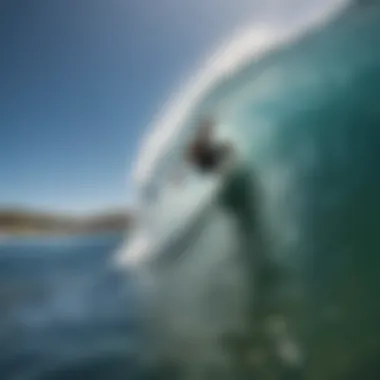
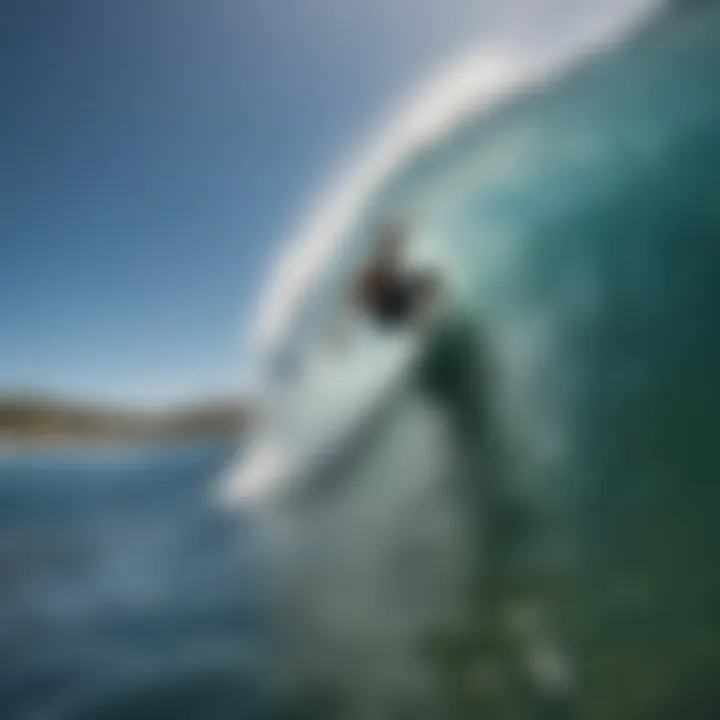
- Rinse with Fresh Water: Remove any loose debris by rinsing it under fresh water. Make sure to open all compartments and thoroughly rinse any crevices where sand or salt may hide. Remember, while you might think, "Well, it’ll clean itself next time I rinse it," that’s a recipe for disaster.
- Drying: Pat the camera down with a soft, lint-free cloth. Avoid using paper towels to scrub; they can leave scratches. Instead, just gently dab the surface to absorb any remaining moisture. Air it out! Letting it dry completely before stashing it away prevents molds or internal corrosion.
- Lenses and Filters: Use a special microfiber cloth to clean the lens. You might think to clear it after each use, but that should be regular practice. And don’t forget to check if there’s any residue on the filters too. You want clear shots, right?
Protective Case Options
Investing in a good protective case is like putting on a second skin for your camera, or perhaps a sturdy life jacket. It acts as a buffer against potential damage from drops or unexpected encounters with rocks. Here are a few options to consider when looking for a protective case:
- Hard Cases: These are great for serious adventurers. Check if they are waterproof and shock-resistant. Often, hard cases come with foam inserts that you can customize to snugly fit your camera.
- Soft Cases: If you prefer something less bulky, look for padded soft cases that provide decent protection against bumps while remaining lightweight.
- Universal Designs: Many brands offer cases that fit a variety of models. Just ensure they align with your camera’s waterproofing and functionality needs. You wouldn’t want to end up with a fancy case that doesn’t protect your gear properly!
"Much like life, maintaining your waterproof camera requires attention to detail, or you risk losing the moments that matter most."
Choosing the right cleaning technique and protective case will elongate the lifespan of your waterproof camera and enhance your overall surfing experience. Keep your gear well-maintained, and it'll pay you back by continuing to capture those unforgettable moments on the water.
Photography Techniques for Surfers
When it comes to capturing the thrill and beauty of surfing, having the right camera is only half the battle. The other crucial part is knowing how to use that camera to its full potential. This section dives into the photography techniques tailored for surfers, covering the essential elements that elevate your shots from mundane to mesmerizing. By understanding these techniques, surfers can not only document their adventures but also create art.
Framing and Composition Basics
The foundation of any great photograph lies in its composition. Good composition can turn a simple picture of a wave into a breathtaking image that tells a story. Here are a few basic tips to achieve this:
- Rule of Thirds: Divide your frame into thirds both horizontally and vertically. The key elements of your shot should be placed along these lines or at their intersections. For example, when photographing a surfer, place them off-center for a more dynamic shot.
- Leading Lines: Use natural lines within the scene to draw the viewer’s eye. The curvature of a wave or even footprints in the sand can serve as leading lines, guiding attention to the surfer.
- Foreground and Background: Incorporating elements both in the foreground and background adds depth. Consider including parts of the beach or surfboards as foreground elements to frame your surfer.
By paying attention to these composition basics, surfers can capture scenes that portray the essence of their surroundings beautifully.
Utilizing Natural Light
Lighting plays a pivotal role in photography, and nothing beats natural light. While at the beach, consider the time of day. Early mornings or late afternoons offer softer light and longer shadows, which can enhance the textures of the waves. Here are some practical tips for working with natural light:
- Golden Hour: Shoot during the golden hour—just after sunrise or just before sunset. The warm tones can add an ethereal quality to your images,
- Watch for Reflections: Water surfaces can reflect light beautifully. When the sun glistens off a wave or a surfer’s board, it adds an extra element to your shots.
- Try Backlighting: Depending on where the sun is, backlighting can create dramatic effects. A surfer riding into the sun can yield a striking silhouette, showcasing the outline of their body against the brightness.
Mastering how to use natural light can significantly enhance the quality of your surfing photographs, making them stand out.
Capturing Action Shots
Surfing is all about action, and capturing those moments takes a bit of skill. Here are some techniques to freeze those thrilling instances in time:
- Fast Shutter Speed: Set your camera to a fast shutter speed. This will help freeze the motion, allowing you to capture the precise moment when a surfer catches a wave, or performs a trick.
- Continuous Shooting Mode: Use the burst mode on your camera for sequences. This allows you to take multiple shots in quick succession, making it easier to capture that perfect split-second of action.
- Anticipate Movement: To capture the essence of surfing, learn to anticipate the surfer’s moves. If you know they tend to maneuver in a specific way, position yourself accordingly. It’s like dance, and knowing the routine can help you get the best shots.
With these action-shot techniques, surfers can create thrilling images that encapsulate the energy of the sport, all while showcasing their skill and passion for riding the waves.
Remember, photography is as much about practice as it is about technique. The more you shoot, the better you'll understand how to capture those spectacular moments. Try different angles, experiment with settings, and most importantly, enjoy the process.
Accessories to Enhance Your Photography Experience
Choosing the right accessories can significantly elevate your experience when using a waterproof camera for surfing. The right gear not only complements your camera but also allows you to capture moments with greater precision and creativity. Let's dive deeper into three critical accessories that can enhance your photography experience: mounts and stabilizers, additional lenses and filters, and memory cards and storage solutions.
Mounts and Stabilizers
One of the best ways to take your surf photography to the next level is by utilizing mounts and stabilizers. These accessories provide the security and support needed to keep your camera steady while hitting the waves. After all, it's not just about being able to take pictures; it's about capturing crisp, clean images amidst the chaos of splashing water and moving boards.
- Versatility: Mounts come in various styles, from helmet mounts to chest mounts, letting you attach your camera in the most advantageous position to get that perfect shot. A stabilized camera can significantly reduce image shake, making your photos far more appealing.
- Creative Angles: Some mounts allow for more dynamic angles, making it easier to capture the action from the right perspective. Whether you’ve got a GoPro or another brand, having the flexibility can help you change your perspective and create unique compositions.
Using a stabilizer, like a gimbal, can also help in this endeavor. Gimbals manage the tilt and roll of your camera, ensuring smooth footage even in tumultuous conditions, giving you an edge when it comes to creating appealing videos.
Additional Lenses and Filters
To truly harness the potential of your waterproof camera, additional lenses and filters are crucial. With various lens attachments, you can shift your photography from standard to spectacular without breaking a sweat.
- Wide-Angle Lenses: A wide-angle lens can widen your field of view, allowing more of the ocean and the surfer into the shot. This is particularly compelling when you want to capture the grandeur of a wave along with the surfer navigating it.
- Polarizing Filters: These filters can help manage reflections on the water's surface, enhancing colors and clarity. It’s like putting sunglasses on your lens; the water's a-twinkle, and your shots will pop with vibrancy.
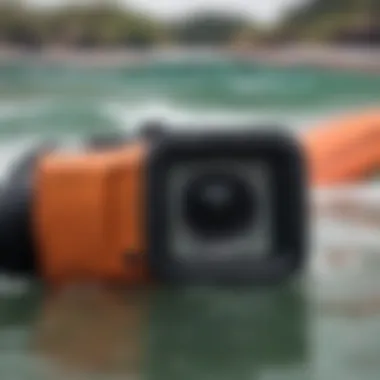
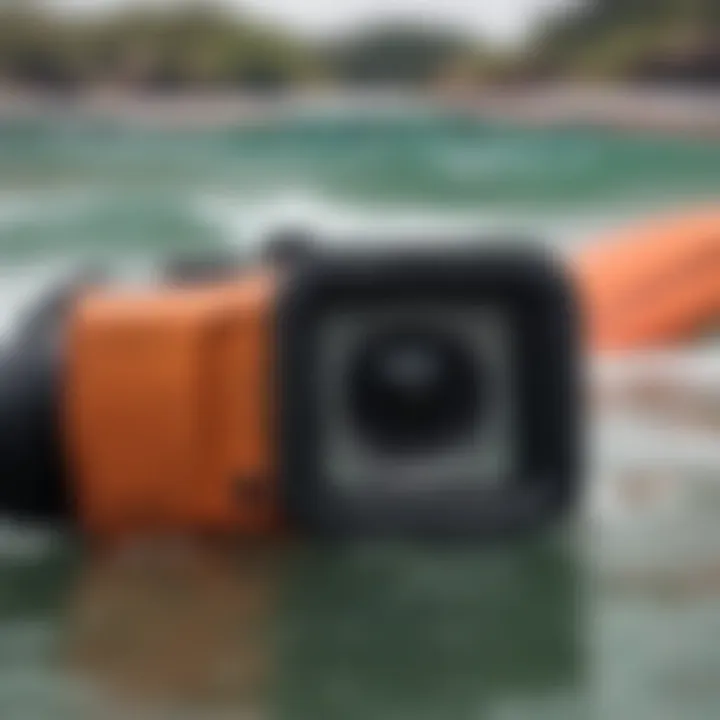
Investing in these accessories means your waterproof camera isn’t just a basic device for snapping pictures but rather a versatile creative tool that can adapt to various scenarios.
Memory Cards and Storage Solutions
Next up is the often overlooked yet essential aspect of photography: memory cards and storage solutions. When you’re out capturing the thrills of surfing, the last thing you want is to run out of space at a critical moment.
- High Capacity: Opt for high-capacity memory cards that allow you to shoot in burst mode without worrying about storage limits. Brands like SanDisk and Lexar offer cards with storage up to several hundred gigabytes, perfect for mitigating those 'out of space' moments.
- Speed Matters: Equally important is the writing speed of the memory cards. A fast card ensures that your camera can save images quickly, allowing for rapid succession shooting, which is ideal when capturing surfers in action.
Also, consider external storage drives for backups. These can keep your data safe from any mishaps that might occur while on the water.
Investing in the right accessories isn't just a nice-to-have; it’s imperative for serious surfers and photographers who want their work to reflect the beauty and excitement of their passion in a way that resonates.
By equipping yourself with the right mounts, filters, and storage solutions, you can turn your waterproof camera into a powerful ally in surf photography, enabling you to seize the moment just as it unfolds amidst nature's unpredictable beauty.
Common Challenges with Waterproof Cameras
Choosing a waterproof camera for surfing comes with its share of challenges. It's not just about waterproofing but understanding how different circumstances affect your photography experience. Anyone with a passion for capturing shots while riding the waves must grapple with these complications to ensure the gear doesn’t become a headache. Each issue demands attention, affecting not only your ability to shoot but also the quality of the images and your enjoyment of the sport.
Battery Life Considerations
When you’re out in the surf, the last thing you want is for your camera to give out right when the action gets exciting. Battery life is a critical consideration when selecting a waterproof camera. Most models have limited battery strength, primarily influenced by various factors such as temperature and usage. Cold water can drain batteries quicker than you might think. Surfers often find themselves in cool to cold conditions, which could put a strain on the performance.
Here are some useful tips to manage your camera’s battery life:
- Charge your batteries fully before your surf sessions.
- Keep a spare battery on hand if possible, especially for extended shoots.
- Turn off any unnecessary features, like Wi-Fi or GPS, when you know you won't be using them.
By being mindful of these elements, you can make sure your camera is ready when the perfect wave rolls in.
Handling Image Quality in Water
Achieving top-notch image quality while shooting underwater or in wet conditions can be quite tricky. Water can scatter light in unpredictable ways, leading to underwater shots that lack clarity or color. Handling image quality in such scenarios demands a bit more than just aiming and clicking.
Here are some crucial aspects to improve your underwater photography with waterproof cameras:
- Use a camera with good aperture range: This helps in capturing more light and reduces the chances of grainy images.
- Experiment with different angles: Shooting from above or below the surface can yield different results, and changing your angle often improves picture quality.
- Adjust white balance: Most waterproof cameras allow some control over white balance settings. Ensure you’re familiar with how to use these settings effectively.
“An aesthetically pleasing image is often a combination of timing, technique, and technical understanding.”
In essence, working with a waterproof camera means getting to grips with quirks specific to its design and functionality. By understanding these common challenges, surfers are better equipped to make informed decisions and improve their photography experience out on the water.
The Future of Waterproof Cameras in Watersports
The landscape of waterproof cameras is evolving rapidly, reflecting broader trends in technology and consumer expectations. As surf culture places a premium on capturing breathtaking moments, the importance of understanding the upcoming features and innovations cannot be understated. These cameras are not just tools, they have become essential companions for surfers, allowing them to share their adventures and experiences in capturing the thrill of the ride. The future of waterproof cameras for watersports promises not only improvements in functionality but also external design elements to enhance user experience.
Technological Advancements
In recent years, technological advancements in waterproof cameras have been nothing short of remarkable. The push for higher image quality often takes center stage. Expect to see improvements in sensor technology, which allows for better low-light performance and higher resolutions. This means even under the challenging conditions of a wave crashing or in the twilight hours, surfers will be able to capture images that are sharper and more vibrant than ever.
Wireless connectivity is also a crucial enhancement. Streamlining the process of sharing captures on social media or streaming live feeds right from the water brings an immediacy that today’s surf aficionados crave. Imaging processing software continues to get smarter, assisting in stabilizing footage or optimizing colors without the need of external editing tools.
- High Dynamic Range (HDR): This will play an important role in how well cameras perform in varying light conditions typically seen while surfing in the ocean.
- Artificial Intelligence (AI): Expect advanced features such as automatic scene recognition to help in the capture of perfect shots as the AI analyzes the environment, determining the best settings for the situation.
"As technology keeps pushing boundaries, it’s not just about capturing the moment but about refining it into a piece of art."
Potential Innovations in Design
When it comes to design, future waterproof cameras are anticipated to become sleeker and more user-friendly. This shift could mean lighter materials that don’t compromise strength and sturdiness, giving surfers the freedom to maneuver and take it with them on all waves, big or small.
Furthermore, a trend towards modular designs is emerging. This would allow surfers to customize their cameras with different lenses, attachments, or protective casings based on the surfing conditions or personal preferences. This adaptability could cater to all sorts of surf scenarios, from large swells to tranquil mornings on the shore.
Ergonomics will likely be in the spotlight too. With various grip designs, buttons, and layouts, manufacturers will be more attentive to how even the smallest details can affect usability during an exhilarating surf session. Features promising better waterproof seals or even temperature resistance will also be significant.
- Flexible Screens: A screen that can be used in varied angles will let surfers capture themselves while riding a wave.
- Integrated GPS and Tracking Features: Ideal for those who want to explore new surf spots and keep logs of their sessions.
As we look forward, the excitement around waterproof cameras extends beyond technical specifications. It embodies a community eager to preserve its essence and thrill through high-tech yet approachable gear. This journey into the future of waterproof cameras holds great promise for enhancing not just storytelling but the very experience of surfing itself.















